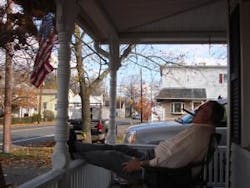As we approach another national firefighter safety week, let me offer a few thoughts to guide your actions in the weeks and months which lie just ahead of us. Let me strongly advise you that people are our most important asset. How often have you heard someone say that?
Sadly, there are far too many for whom this phrase is mere window dressing. These people really upset the apple cart of my well-ordered life. Let me say it one more time, just so you will get the drift of my message. A life which is lost can never be replaced. The pain and suffering brought on by job-related injuries can be a drain on fire department resources. More than that, these things can rob you of the services of your people.
Safety must become a critical element for your fire department. But safety can only occur if the light of a brilliant idea comes on in someone's head. Preferably that light bulb will blink on in the head of the Chief and/or one of the other officers in your department. Someone who has enough power to get this important task accomplished.
Sadly this is not always the case. Fire service leaders sometimes grow out of touch with the people in the fire stations. This is a dangerous trend. However, it is one that we have seen far too often. Worse yet are those fire chiefs and other people in positions of leadership who just don't give a damn about safety.
However, once the decision to pursue organizational safety has been made, the next stop should be the code book. There are a number of important tasks which must be done by the fire department in order to develop a safety structure for the organization.
1. Develop a Fire Department Organizational Statement
2. Create a risk management plan
3. You will have to create policy (an organizational way of doing things.)
4. Define roles and responsibilities
5. Appoint a department safety officer
6. Set up a committee
7. Develop a training program
8. Develop a vehicular training program
9. Buy them safe, train safe, keep it safe
10. Protective clothing
11. Emergency Operations
12. Facility safety
13. Medical and Physical Program
14. Member assistance programs
The road to safety is truly a long and winding path. The journey must be made by all parties concerned. It cannot just be a paper plan of the leaders, or an informal plan created by the people fighting the fires. There is a great deal of hard work and heart burn in working together to develop an official safety program. But it beats the hell out of hurting or killing people.
Be sure that all of your operating personnel receive a medical examination on a yearly basis. It is best if you begin with a thorough entrance physical to establish a baseline for assessing an individual's physical condition. In this way each annual physical charts the effect of firefighting on the individual. And it can provide appropriate warning if an individual begins to develop job- related physical problems.
Having recruited healthy candidates into your department, it is up to you to see that they stay that way. One good method is through the use of a physical conditioning program. Counseling on diet and life style are also important. Bad habits, whether on or off duty, can have a negative impact on job performance.
Training is one area that does not receive enough credit for being a part of a fire department safety program. If people are taught the correct way to perform their duties they will operate in a safer manner, with a lesser chance of injury. In-service drills and periodic refresher training keep people going in a positive direction. If you teach people proper techniques and monitor performance your efforts can limit injuries and possibly prevent death.
Organizational efforts are one thing. However, it is on the fire scene where things have a great potential for maiming or killing our troops. What are some things which you must do at every fire to keep your people safe? Since most injuries occur at the scene of fires, we will concentrate in this area.
1. Fires are not unpredictable. However if firefighters and officers ignore what a fire might do, they stand a good chance of being injured
2. If it is cold, dress warmly. Watch where you are walking and be careful on ice. We shoot lots of water and nature insures that it will freeze in cold weather.
3. If it is hot, conserve your efforts to the greatest extent possible. Rotate your operational forces frequently. Insure that fluids are available. Be sure that your local EMS component is available to monitor the physical condition of your people.
4. Use self-contained breathing apparatus. And do not limit your use to interior operations. Vehicle fires can generate dangerous levels of toxic smoke.
5. Monitor the fatigue level of your personnel. Tired people are more apt to become injury statistics.
6. When using forcible entry tools, keep an eye out for people who feel they must wander near to you. They may have an unconscious desire to be struck on the head. Do not help them along.
7. When climbing ladders, be sure that you have someone securing the base of the ladder as you climb.
8. Do not overload ladders. Refer to the manufacturers specifications for guidance.
9. Be aware of the fire building. Does it have a bow- string truss supporting the roof? Might it have one of those new rubber roofs that can hide a multitude of structural sins? Or could it be a light-weight truss or metal pan deck, just waiting to drop an unsuspecting firefighter into the blaze?
10. Do not day dream when it comes to assessing construction. Are there cracks in the walls? Are the floors sagging? If you are up on the roof is it solid or spongy? Or is it a new roof style where you cannot tell the difference.
11. What is the potential for collapse? There is no sure guide as to whether a wall will fall a little or a lot. We always treat them like it will be a lot, if it happens. It's safer that way.
12. Keep your aerial devices away from electric lines. Be at least 10 feet away, more if they are high tension. Not only does it make good sense, it is the law.
13. Keep your breathing apparatus on during overhaul.
14. Give your teammates room when they are using hooks and axes to overhaul a fire building. They need room to maneuver.
15. Pay attention to what you are doing. Day dreaming can be dangerous.
For more information of safety, we strongly recommend that you obtain the IFSTA text on Firefighter Occupational Safety. It will cover each area mentioned above in much greater detail. Let me also suggest that you review the appropriate National Fire Protection Association standards as well as any current state and local laws, standards, or operational guidelines which apply to your department.
We urge you to make safety a part of your life. All that has been taught in this text revolves around the safe application of the information. The alternative is not an appetizing prospect. It has been my long-time experience that death is a permanent condition.
About the Author

Dr. Harry Carter
HARRY R. CARTER, Ph.D., who is a Firehouse contributing editor, is a fire protection consultant based in Adelphia, NJ. He is chairman of the Board of Commissioners in Howell Township Fire District 2 and retired from the Newark, NJ, Fire Department as a battalion commander. Carter has been a member of the Adelphia Fire Company since 1971, serving as chief in 1991. He is a life member and past president of the International Society of Fire Service Instructors and life member of the NFPA. He is the immediate past president of the U.S. branch of the Institution of Fire Engineers (IFE) of Great Britain. Carter holds a Ph.D. in organization and management from Capella University in Minneapolis, MN.
Connect with Harry:
Email: [email protected]
Sign up for our eNewsletters
Get the latest news and updates
